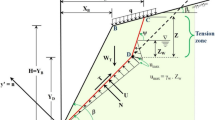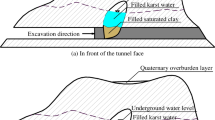Abstract
The geological hazards, such as water inrush and mud outburst, are easily induced by the high water pressure caverns ahead of a karst tunnel face. Therefore, it is a pivotal issue to determine the reserved thickness of rock plug during the construction of tunnels. The limit analysis principle is employed to analyze the safe thickness from the point of energy dissipation, and the nonlinear and non-associated characteristics of geotechnical materials are both considered. On the basis of a plane failure pattern of rock plug, the expressions of detaching curve and rock plug thickness are derived. The effect of each parameter on the safe thickness of rock plug is discussed in detail, which interprets the corresponding failure scope of rock plug. The obtained results indicate that the thickness of rock plug is highly influenced by the nonlinear dilatancy coefficient and the nonlinear coefficient. The proposed method is validated by a comparison of the calculated results with those of the engineering project of the “526 karst cavern” of Yunwushan tunnel. This proposed method can provide reference basis for the design and excavation of karst tunnels in the future.
Similar content being viewed by others
References
LIU Chao-qun, PENG Hong-jun. Analysis of the safe distance between a tunnel face and karst cave [J]. Modern Tunnelling Technology, 2012, 49(3): 109–113. (in Chinese)
WU Q, WANG M, WU X. Investigations of groundwater bursting into mine seam floors from fault zones [J]. International Journal of Rock Mechanics and Ming Sciences, 2004, 41(4): 557–571.
LI Li-ping, LI Shu-cai, ZHANG Qing-song. Study of mechanism of water inrush induced by hydraulic fracturing in karst tunnels [J]. Rock and Soil Mechanics, 2010, 31(2): 523–528. (in Chinese)
MEGUID M A, DAND H K. The effect of erosion voids on existing tunnel linings [J]. Tunneling and Underground Space Technology, 2008, 4(2): 1–9.
YANG X L, LI Z W. Factor of safety of three-dimensional stepped slope [J]. International Journal of Geomechanics, 2018, 18, DOI: 10.1061/(ASCE)GM.1943-5622.0001154.
YANG X L, YAO C. Stability of tunnel roof in nonhomogeneous soils [J]. International Journal of Geomechanics, 2018, 18, DOI: 10.1061/(ASCE)GM.1943-5622.0001104.
LI T Z, YANG X L. Risk assessment model for water and mud inrush in deep and long tunnels based on normal grey cloud clustering method [J]. KSCE Journal of Civil Engineering, 2018, 22, DOI: 10.1007/s12205-017-0553-6.
XU J S, YANG X L. Effects of seismic force and pore water pressure on three dimensional slope stability in nonhomogeneous and anisotropic soil [J]. KSCE Journal of Civil Engineering, 2018, 22, DOI: 10.1007/s12205-017-1958-y.
FRALDI M, GUARRACINO F. Limit analysis of collapse mechanisms in cavities and tunnels according to the Hoek–Brown failure criterion [J]. International Journal of Rock Mechanics and Mining Sciences, 2009, 46(4): 665–673.
PAN Q, DIAS D. Face stability analysis for a shield-driven tunnel in anisotropic and nonhomogeneous soils by the kinematical approach [J]. International Journal of Geomechanics, 2016, 16(3): 04015076.
LECA E, DORMIEUX L. Upper and lower bound solutions for the face stability of shallow circular tunnels in frictional material [J]. Geotechnique, 1990, 40(4): 581–606.
SOUBRA A H. Three-dimensional face stability analysis of shallow circular tunnels[C]// International Society for Rock Mechanics. Melbourne: CRC, 2000: 19–24.
YANG X L. Lower bound analytical solution for bearing capacity factor using modified Hoek–Brown failure criterion [J]. Canadian Geotechnical Journal, 2018, 55, DOI: 10.1139/cgj-2016-0694.
YANG X L. Effect of pore-water pressure on 3D stability of rock slope [J]. International Journal of Geomechanics, 2017, 17(9): 06017015.
YANG X L, ZHANG R. Limit analysis of stability of twin shallow tunnels considering surface settlement [J]. KSCE Journal of Civil Engineering, 2018, 22, DOI: 10.1007/s12205-017-1398-8.
XU J S, PAN Q J, YANG X L, LI W T. Stability charts for rock slopes subjected to water drawdown based on the modified nonlinear Hoek-Brown failure criterion [J]. International Journal of Geomechanics, 2018, 18(1): 04017133.
YIN J H, WANG Y J, SELVADURAI A P. Influence of nonassociativity on the bearing capacity of a strip footing [J]. Journal of Geotechnical and Geoenvironmental Engineering, 2001, 127(11): 985–989.
LUO W H, LI W T. Reliability analysis of supporting pressure in tunnels based on three-dimensional failure mechanism [J]. Journal of Central South University, 2016, 23(5): 1243–1252.
YANG X L, LI Z W, LIU Z A, XIAO H B. Collapse analysis of tunnel floor in karst area based on Hoek-Brown rock media [J]. Journal of Central South University, 2017, 24(4): 957–966.
YANG X L, ZHANG R. Collapse analysis of shallow tunnel subjected to seepage in layered soils considering joined effects of settlement and dilation [J]. Geomechanics and Engineering, 2017, 13(2): 217–235.
AGAR J G, MORGENSTERN N R, SCUT J D. Shear strength and stress-strain behaviour of Athabasca oil sand at elevated temperatures and pressures [J]. Canadian Geotechnical Journal, 1987, 24(1): 1–11.
LUQUE R F, MANDL G. Fully Developed Plastic Shear Flow of Granular Materials [J]. Géotechnique, 1970, 20(3): 277–307
DRESCHER A, DRTOURNAY E. Limit load in translational failure mechanisms for associative and non-associative materials [J]. Géotechnique, 1993, 43(3): 443–456.
LI T Z, YANG X L. Reliability analysis of tunnel face in broken soft rocks using improved response surface method [J]. International Journal of Geomechanics, 2018, 18, DOI: 10.1061/(ASCE)GM.1943-5622.0001129.
LI T Z, LI Y X, YANG X L. Rock burst prediction based on genetic algorithms and extreme learning machine [J]. Journal of Central South University, 2017, 24(9): 2105–2113.
LI T Z, YANG X L. Limit analysis of failure mechanism of tunnel roof collapse considering variable detaching velocity along yield surface [J]. International Journal of Rock Mechanics and Mining Sciences, 2017, 100: 229–237.
PESENDORFER M, LOEW S. Subsurface exploration and transient pressure testing from a deep tunnel in fractured and karstified limestones [J]. International Journal of Rock Mechanics and Mining Sciences, 2010, 47(1):121–137.
GUO Jia-qi. Study on against-inrush thickness and water-burst mechanism of karst tunnel [D]. Beijing: Beijing Jiaotong University, 2011. (in Chinese)
Author information
Authors and Affiliations
Corresponding author
Additional information
Foundation item: Project(2013CB036004) supported by the National Basic Research Program of China; Projects(51378510, 51308072) supported by National Natural Science Foundation of China; Project(CX2014B069) supported by the Hunan Provincial Innovation Foundation for Postgraduate, China
Rights and permissions
About this article
Cite this article
Yang, Zh., Zhang, R., Xu, Js. et al. Energy analysis of rock plug thickness in karst tunnels based on non-associated flow rule and nonlinear failure criterion. J. Cent. South Univ. 24, 2940–2950 (2017). https://doi.org/10.1007/s11771-017-3708-1
Received:
Accepted:
Published:
Issue Date:
DOI: https://doi.org/10.1007/s11771-017-3708-1




